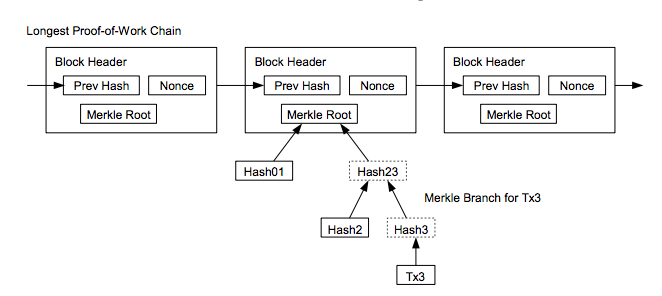Block Chain
Block Chain
찾아본 계기
- 2016.10.20 블록체인관련 Tech Planet 2016에서의 발표를 이진석 (당시 CTO, 블로코)님께서 하시는데 거의 못 알아들음.
- 2017.09.08 함께일하는 동료 5명중 나를 뺀 4명이 비트코인 투자를 시작하며 저에게도 권유. 빗썸이란 곳은 가입하면 1000원을 준다길래 가입 후 200원 리플을 5개 사두고 관심을 끔. Blcok chain 기술마저 관심을 끄고 지냄.
- 2018.01.08 우연히 들어보니 20배가 올라서 가보니 1000 ➜ 약 21000원이 되어있음.
- 돈이 생겼으니 버릴 수는 없고 Bithumb API를 이용해서 자동으로 사고팔 기능을 구현해서 일단 시작.
- 기왕 이렇게 된거 block chain 기술부터 확인해봐야겠다고 생각하고 확인 시작
- Block chain 관련 서적을 사보기 전에 개념확인
정의
- A blockchain, originally block chain, is a continuously growing list of records, called blocks, which are linked and secured using cryptography. Each block typically contains a hash pointer as a link to a previous block, a timestamp and transaction data.1
- The first blockchain was conceptualized in 2008 by an anonymous person or group known as Satoshi Nakamoto and implemented in 2009 as a core component of bitcoin where it serves as the public ledger for all transactions.1
- A Peer-to-Peer Electronic Cash System 2
- 근본적으로 분산 데이터 저장기술의 한 형태로, 지속적으로 변경되는 데이터를 모든 참여 노드에 기록한 변경 리스트로서 분산 노드의 운영자에 의한 임의 조작이 불가능하도록 고안되었다. 잘 알려진 블록체인의 응용사례는 암호화폐의 거래과정을 기록하는 탈중앙화된 전자장부로서 비트코인이 있다. 이 거래 기록은 의무적으로 암호화되고 블록체인 소프트웨어를 실행하는 컴퓨터상에서 운영된다. 비트코인을 비롯한 대부분의 암호화폐들이 블록체인 기술 형태에 기반하고 있다3
- 관리 대상 데이터를 ‘블록’이라고 하는 소규모 데이터들이 P2P방식을 기반으로 생성된 체인 형태의 연결고리 기반 분산 데이터 저장환경에 저장되어 누구도 임의로 수정될 수 없고 누구나 변경의 결과를 열람할 수 있는 분산컴퓨팅 기술 기반의 데이터 위변조 방지 기술이다. 이는 근본적으로 분산 데이터 저장기술의 한 형태로, 지속적으로 변경되는 데이터를 모든 참여 노드에 기록한 변경 리스트로서 분산 노드의 운영자에 의한 임의 조작이 불가능하도록 고안되었다. 4
- 가장 활발히 사용되는 Bitcoin: The world’s first completely decentralized digital currency.5
Blockchain 코드 분석
- Daniel van Flymen님의 Github Code
- 코드도 간결하고, 시험하기도 쉽습니다.
사용하는 라이브러리
- hash는 hashlib 사용
import hashlib
import json
from time import time
from urllib.parse import urlparse
from uuid import uuid4
import requests
from flask import Flask, jsonify, request
초기화
class Blockchain:
def __init__(self):
self.current_transactions = []
self.chain = []
self.nodes = set()
# Create the genesis block
self.new_block(previous_hash='1', proof=100)
- 여기서 genesis block에 대한 그림 출처

Figure 1. Genesis, Main, Orphan block
노드 등록
def register_node(self, address):
"""
Add a new node to the list of nodes
:param address: Address of node. Eg. 'http://194.168.0.5:5000'
"""
parsed_url = urlparse(address)
self.nodes.add(parsed_url.netloc)
신규 블록 생성
- Transaction

Figure 2. Chain concept
- Timestamp

Figure 3. Timestamp Server
- Proof of work

Figure 4. Proof of Work
def new_block(self, proof, previous_hash):
"""
Create a new Block in the Blockchain
:param proof: The proof given by the Proof of Work algorithm
:param previous_hash: Hash of previous Block
:return: New Block
"""
block = {
'index': len(self.chain) + 1,
'timestamp': time(),
'transactions': self.current_transactions,
'proof': proof,
'previous_hash': previous_hash or self.hash(self.chain[-1]),
}
# Reset the current list of transactions
self.current_transactions = []
self.chain.append(block)
return block
신규 트랜잭션 생성
def new_transaction(self, sender, recipient, amount):
"""
Creates a new transaction to go into the next mined Block
:param sender: Address of the Sender
:param recipient: Address of the Recipient
:param amount: Amount
:return: The index of the Block that will hold this transaction
"""
self.current_transactions.append({
'sender': sender,
'recipient': recipient,
'amount': amount,
})
return self.last_block['index'] + 1
Chain의 유효성 검사
- Simplified Payment Verification

Figure 5. Simplified Payment Verification
def valid_chain(self, chain):
"""
Determine if a given blockchain is valid
:param chain: A blockchain
:return: True if valid, False if not
"""
last_block = chain[0]
current_index = 1
while current_index < len(chain):
block = chain[current_index]
print(f'{last_block}')
print(f'{block}')
print("\n-----------\n")
# Check that the hash of the block is correct
if block['previous_hash'] != self.hash(last_block):
return False
# Check that the Proof of Work is correct
if not self.valid_proof(last_block['proof'], block['proof']):
return False
last_block = block
current_index += 1
return True
def proof_of_work(self, last_proof):
"""
Simple Proof of Work Algorithm:
- Find a number p' such that hash(pp') contains leading 4 zeroes, where p is the previous p'
- p is the previous proof, and p' is the new proof
"""
proof = 0
while self.valid_proof(last_proof, proof) is False:
proof += 1
return proof
@staticmethod
def valid_proof(last_proof, proof):
"""
Validates the Proof
:param last_proof: Previous Proof
:param proof: Current Proof
:return: True if correct, False if not.
"""
guess = f'{last_proof}{proof}'.encode()
guess_hash = hashlib.sha256(guess).hexdigest()
return guess_hash[:4] == "0000"
@staticmethod
def hash(block):
"""
Creates a SHA-256 hash of a Block
:param block: Block
"""
# We must make sure that the Dictionary is Ordered, or we'll have inconsistent hashes
block_string = json.dumps(block, sort_keys=True).encode()
return hashlib.sha256(block_string).hexdigest()
충돌확인
def resolve_conflicts(self):
"""
This is our consensus algorithm, it resolves conflicts
by replacing our chain with the longest one in the network.
:return: True if our chain was replaced, False if not
"""
neighbours = self.nodes
new_chain = None
# We're only looking for chains longer than ours
max_length = len(self.chain)
# Grab and verify the chains from all the nodes in our network
for node in neighbours:
response = requests.get(f'http://{node}/chain')
if response.status_code == 200:
length = response.json()['length']
chain = response.json()['chain']
# Check if the length is longer and the chain is valid
if length > max_length and self.valid_chain(chain):
max_length = length
new_chain = chain
# Replace our chain if we discovered a new, valid chain longer than ours
if new_chain:
self.chain = new_chain
return True
return False
마지막 블록정보 가져오기
@property
def last_block(self):
return self.chain[-1]
Flask를 이용한 테스트 코드
# Instantiate the Node
app = Flask(__name__)
# Generate a globally unique address for this node
node_identifier = str(uuid4()).replace('-', '')
# Instantiate the Blockchain
blockchain = Blockchain()
@app.route('/mine', methods=['GET'])
def mine():
# We run the proof of work algorithm to get the next proof...
last_block = blockchain.last_block
last_proof = last_block['proof']
proof = blockchain.proof_of_work(last_proof)
# We must receive a reward for finding the proof.
# The sender is "0" to signify that this node has mined a new coin.
blockchain.new_transaction(
sender="0",
recipient=node_identifier,
amount=1,
)
# Forge the new Block by adding it to the chain
previous_hash = blockchain.hash(last_block)
block = blockchain.new_block(proof, previous_hash)
response = {
'message': "New Block Forged",
'index': block['index'],
'transactions': block['transactions'],
'proof': block['proof'],
'previous_hash': block['previous_hash'],
}
return jsonify(response), 200
@app.route('/transactions/new', methods=['POST'])
def new_transaction():
values = request.get_json()
# Check that the required fields are in the POST'ed data
required = ['sender', 'recipient', 'amount']
if not all(k in values for k in required):
return 'Missing values', 400
# Create a new Transaction
index = blockchain.new_transaction(values['sender'], values['recipient'], values['amount'])
response = {'message': f'Transaction will be added to Block {index}'}
return jsonify(response), 201
@app.route('/chain', methods=['GET'])
def full_chain():
response = {
'chain': blockchain.chain,
'length': len(blockchain.chain),
}
return jsonify(response), 200
@app.route('/nodes/register', methods=['POST'])
def register_nodes():
values = request.get_json()
nodes = values.get('nodes')
if nodes is None:
return "Error: Please supply a valid list of nodes", 400
for node in nodes:
blockchain.register_node(node)
response = {
'message': 'New nodes have been added',
'total_nodes': list(blockchain.nodes),
}
return jsonify(response), 201
@app.route('/nodes/resolve', methods=['GET'])
def consensus():
replaced = blockchain.resolve_conflicts()
if replaced:
response = {
'message': 'Our chain was replaced',
'new_chain': blockchain.chain
}
else:
response = {
'message': 'Our chain is authoritative',
'chain': blockchain.chain
}
return jsonify(response), 200
if __name__ == '__main__':
from argparse import ArgumentParser
parser = ArgumentParser()
parser.add_argument('-p', '--port', default=5000, type=int, help='port to listen on')
args = parser.parse_args()
port = args.port
# app.run(host='127.0.0.1', port=port)
app.run(host='0.0.0.0', port=port)
실제 시험
- 코드로도 알 수 있지만, 모르시겠다면 구현했던 사람이 포스팅한 글에 시험 방식에 대한 내용이 있습니다.
- Learn Blockchains by Building One
- 참고로 step 3에 가면 있습니다.
마무리
- 대충 어떤건지 이해했으니 책을 사서 읽어봐야겠습니다.
참조
-
Bitcoin: A Peer-to-Peer Electronic Cash System 사토시 나카모토 (2008) ↩
-
BITCOIN: A Primer for Policymakers 제리 브리토, 안드레아 카스트로(Jerry Brito and Andrea Castillo) (2013). ↩